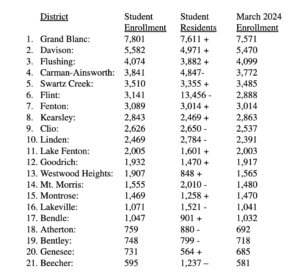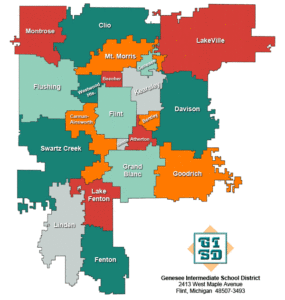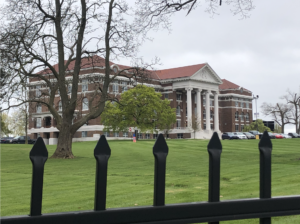By Harold C. Ford
Flint Community Schools (FCS) enrolls just 20 percent of the school-age students that reside within the district’s boundaries, resulting in a loss of $100 million annually as the other 80 percent of its possible students take state funding elsewhere.
Other educational options for those students include: Schools of Choice, wherein public-school students can attend other public schools outside of the district they live in; nonprofit and for-profit charter schools; private schools, such as those offered by the Roman Catholic Church; homeschooling; or dropping out altogether.
An East Village Magazine (EVM) study of Genesee County school enrollment data shows that thousands of area students choose such other options — with each student choosing another option taking with them $9,608 in state aid, annually.
Projected $1 billion loss in a decade
Of the 21 public school systems that are part of the Genesee Intermediate School District (GISD), the district most impacted by the transfer of its students elsewhere is Flint Community Schools.
The first count day of the 2023-24 school year showed that 10,661 of the 13,456 kindergarten to 12th grade students with Flint addresses did not enroll in Flint’s public school system. Doing the math, those 10,661 students took with them $102,430,888 million in state aid.
Projected over a decade, that would equate to a staggering loss of more than $1 billion to the Flint school district.
Where are they going?
In recent decades, educational options have multiplied far beyond the local public school system to include Schools of Choice, charter schools, private schools, and homeschooling. Below is a breakdown of how those options factor into Flint Schools’ enrollment loss.
Schools of Choice
Since 1996, Michigan’s public-school students have been able to transfer to another public school system that participates in the state’s Schools of Choice option. That results in some public school systems in Genesee County enrolling more students than the number that actually live in the district, while other districts enroll fewer.
Each transferring student also transfers state aid to the district in which they enroll. That state aid amount for the 2023-2024 school year is $9,608, according to the Michigan Department of Education.
Therefore, just ten students represent $96,080 in state aid; 100 students represent $960,800; and so on. Those amounts can significantly impact a school budget.
The table below is pulled from data provided by the National Center for Education Statistics (NCES). It shows the 21 public school systems in Genesee County followed by student enrollment numbers – ordered largest to smallest – that existed at the start of the 2023-2024 school year.
Student enrollment numbers are followed by the number of students that reside in the school district with a plus (+) sign if student enrollment exceeds the number of student residents in the district, or a minus (-) sign if student enrollment is less than the district’s number of student residents.
The final column on the right shows enrollment numbers taken on the second student count day of the 2023-2024 school year. (Please note: EVM used the first student count day numbers for purposes of this report.)

Takeaways from the above data show that 12 districts enrolled more students than actually lived in the district this school year, while nine districts enrolled fewer.
Westwood Heights was the biggest winner, with enrollment more than doubling the number of K-12 students that live within the district.

(Image source: Genesee County Intermediate School District)
Conversely, Flint was the biggest loser, with a loss of 13,456 students. Thus, while Flint started this school year as the sixth largest school system in Genesee County, the latest enrollment numbers indicate that Fenton has now bumped Flint into the seventh position — and that Kearsley, in eighth position, is just 25 students behind Flint.
In Genesee County, two high school-college hybrids, Mott Middle College and Genesee Early College, offer an alternative to enrollment in the county’s public schools and are thus also considered Schools of Choice.
Mott Middle College opened in 1991 and operates on the campus of Mott Community College, and Genesee Early College is housed at the University of Michigan-Flint. Both schools offer students the opportunity to earn high school and college credits.
These high school-college hybrids do receive state aid for enrolled students, though enrollment numbers were not immediately available on their websites to determine how much.
Charter schools
While some potential FCS students are opting for adjacent school districts, others land in charter schools around the county.
Charter schools have existed in Michigan since the 1990s. Like public schools in Michigan, public charters receive state funding, are required to administer standardized tests required by the state, and must be open to all students in terms of enrollment.
In Genesee County, 14 public charters are currently listed by the Michigan Department of Education. They are (with enrollment numbers):
- Burton Glen Charter Academy (715)
- Eagle’s Nest Academy (158)
- Flex High North Flint (249)
- Flint Cultural Center Academy (596)
- Grand Blanc Academy (325)
- Greater Heights Academy (246)
- International Academy of Flint (890)
- Linden Charter Academy (791)
- Madison Academy High School (541)
- Northridge Academy (225)
- Richfield Public School Academy (565)
- New Standard Academy (779)
- WAY Academy of Flint (92)
- Woodland Park Academy (270).
The combined enrollment of public charter schools in Genesee County – 6,442 students – would make it the second largest school population in the county, trailing only Grand Blanc’s public school enrollment. They represent $61,894,736 in state aid that might otherwise help fund the county’s 21 public school systems.
Private schools
The largest collection of private school students in Genesee County are those enrolled in Roman Catholic Schools.
The six area schools listed on the Powers Catholic High School website include: St. John the Evangelist in Fenton; St. Robert Catholic in Flushing; St. John Vianney in Flint; Holy Rosary Catholic School in Flint; Holy Family in Grand Blanc; and Powers Catholic High School in Flint.
Most are pre-K to 8th grade schools, with the exception of Holy Rosary (K-8) and Powers (9-12). Not included in the Powers list is St. Thomas More Academy in Burton, which serves K-12 students.
While Catholic schools do not receive state aid because they provide religious instruction, each enrolled student still represents state aid that might otherwise go to a public school system. Therefore, with a combined total of roughly 1,795 students, Genesee County’s Catholic schools’ student count equates to around $17.3 million in state funding that might otherwise go to area public schools.

Powers Catholic High School in Flint, Mich. (Photo by Kate Stockrahm)
Homeschooling and dropping out
Michigan is one of 11 states where parents are not required to notify anyone that they are homeschooling their child, and there is no registry of homeschool students. These factors make it near-impossible to determine the exact number of homeschool students and/or students who have dropped out in the state, let alone in Flint specifically.
However, on a broader scale, Bridge Magazine estimated in a February 2024 article that about 150,000 students in Michigan are likely homeschooled or have dropped out of school altogether through a calculation of U.S. Census, private, and public school enrollment data.
As stands, the State of Michigan does not appropriate funding for homeschooling, though a local school district may receive some funding for home-schooled students enrolled in “non-essential courses,” as defined by Michigan law, at that local district.
Attracting more students to Flint Community Schools
What’s happening to school enrollment in Flint’s public schools is not uncommon.
Bridge Magazine recently reported that one in four students in Michigan do not attend a public school in the district where they reside — an increase from one in six only a decade earlier.
Still, Flint school leaders are keenly aware of the financial impact of a diminished student population and looking to reverse the trend.
An April 2024 settlement agreement between FCS and the United Teachers of Flint (UTF), and both parties’ subsequent press statements, included multiple references to the need to bring students back to Flint’s public school system.
The agreement language spoke to the “vital needs of increasing student enrollment and retention,” and, at an April 10 press conference, FCS Superintendent Kevelin Jones said, “We need to focus on enrollment campaigns … We also need new enrollees to come back to Flint Community Schools.”
Further, UTF President Karen Christian touted the agreement’s potential toward “helping to recruit students and making sure we keep this district viable.”
Enrollment concerns for Flint Schools go beyond the local level, too. Back in November 2023, Michigan Superintendent of Public Instruction Michael Rice also referenced Flint’s loss of students in remarks before the Flint Board of Education.
“You can’t have the current market share [student enrollment] and make it work,” he said. “You’ve got to grow that market share. You’ve got to bring people back.”


You must be logged in to post a comment.